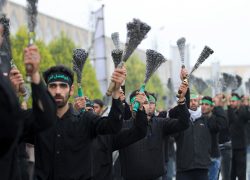A Reflection on the Most Renowned Inscribed Carpets in the Contemporary History of Isfahan, on the Occasion of National Carpet Day
The challenges facing Iranian carpets today are fundamental issues requiring the insight and solutions of art experts, carpet specialists, and industry professionals. However, the Persian carpet—an art form whose origins, according to historians, lie with the nomadic and rural people of this land—boasts a rich and golden history. Particularly in the Safavid era of Isfahan, it reached unparalleled refinement and perfection.
One book in the field of carpets truly deserves attention, offering a chance to escape the tumult and anxieties of our times and find solace in the graceful, elegant, and dignified presence of Persian carpets. This book, “Etiquette and Mysticism in Persian Carpets” (Soroush Publications, 1999), is the work of the late artist and carpet master, Seyed Reza Khoshkenabi.
Khosheknabi, the brother of the celebrated poet of our nation, Master Shahriar, devoted this work to exploring the significance of Quranic verses, hadiths, and poetry woven into the intricate designs of contemporary Persian carpets. In this book, he meticulously recorded the texts inscribed on an exquisite collection of carpets—works that the passage of time may render illegible or perhaps, erase entirely.
One of the remarkable features of this book, which makes reading it even more captivating, is its visual allure and exceptional quality. Each carpet, rug, and prayer mat discussed within its pages is beautifully illustrated alongside detailed explanations, bringing them vividly to life. In the following sections, we will delve into those carpets featured in the book that share a connection with the rich history of art in the enchanting city of Isfahan.
From Divine Words to Persian Poetry on Iranian Carpets
“The Carpet of the Map of Iran” stands as one of the most exquisite artistic masterpieces of Isfahan in modern history. This small carpet was woven during the Qajar era in the city of Isfahan. An inscription on the vibrant and intricately designed carpet reveals the name of its commissioner: “As ordered by Mr. Saham al-Saltaneh, Factory School of Borujen.”
The edges of this carpet, which stir the emotions of any Iranian who gazes upon it, bear several poetic verses. Among them are these profound lines:
“O you, wanderer left behind by the caravan, if you pass by this two-doored abode, enter through one door as the morning breeze, and exit through the other as the radiant sun.”
“The Carpet of the Seven Cities of Love”—symbolizing the cities of Mashhad, Mecca, Medina, Najaf, Karbala, Kadhimiya, and Samarra—is regarded as one of Iran’s unparalleled masterpieces. This carpet, depicting the shrines of Shiite Imams across various cities alongside the Mausoleum of Hazrat Masoumeh (PBUH) and the tombs of Ferdowsi, Saadi, and Hafez, was woven in Isfahan in 1353 AH (1974 CE). Preserved in the Astan Quds Razavi Museum, it mesmerizes viewers with its intricate patterns and vibrant colors, making it nearly impossible to look away. This exquisite work, reflecting the Shiite identity and the deep national sentiments of Iranians, also features several verses from the Holy Quran in Naskh script, with medallion motifs of extraordinary charm.
“The Carpet – Buyer of Another” is a captivating piece that embodies the essence of Iranian literature, mysticism, and calligraphy. Crafted by Master Akbar Mahdiei and woven in Isfahan in 1367 AH (1988 CE), this poetic, multicolored tapestry is adorned with a ghazal by Hafez, inscribed in Ruq’ah script by Master Hassan Changi:
“There is no understanding among this people—God, grant me aid, so I may offer my gem to another buyer.”
“The Pictorial Carpet of Mowlana Saeb Tabrizi” is a splendid representation of the union of poetry, mysticism, and the art of carpet weaving in the beautiful city of Isfahan. The intricate and captivating design of this carpet is attributed to Master Haj Mosavar al-Molki, brought to fruition by Master Hatefi. The carpet is adorned with a poem by Saib Tabrizi, the renowned poet resting in Abbasabad, Isfahan:
“Through the purity of desire, our soul shines bright like dawn; from the cold oven, our bread emerges warm.”
At the heart of the carpet is an image of Saib himself, portrayed in a heavenly abode.
“The Isfahan Prayer Rug”, housed in the Carpet Museum of Iran, is another notable contemporary inscribed masterpiece crafted in this region. This prayer rug features a charming mihrab design accompanied by two minbars and two minarets. Its mesmerizing colors and intricate patterns are undeniably captivating. The inscription on this rug, written in Thuluth script in vibrant blue, calls its viewer to prayer and repentance:
“Hasten to prayer before it is too late, and hasten to repentance before death.”
The carpet’s weaving date is recorded as 1120 AH (1708 CE).







